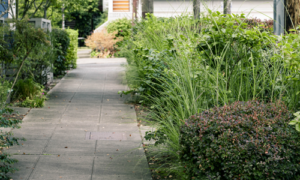The bigleaf maple (Acer macrophyllum), also known as the Oregon maple, is a deciduous, long-lived tree native to the Pacific Northwest. True to its name, it dangles unusually large, 5-lobed, palmate (palm-shaped) leaves from its branches. These goliath photosynthesizers measure up to 30 cm (12 in) wide and almost as long, a singular feature that distinguishes the bigleaf maple from others in the soapberry family, Sapindaceae (though some still place it in Aceraceae). Its leaves and branches grow in an opposite formation, and spread into a domed canopy at maturity. The young bark is smooth and grayish-brown, eventually becoming red-brown and deeply fissured with age. Description from Bigleaf Maple (U.S. National Park Service) (nps.gov)
Home > Plant Guide >
Scientific Name
Family
Garden Type
Wildlife
Native Plant Region
Light needs
Water Needs
Plant Type
Bloom Color(s)
Height
Width
Months in Bloom
Safe Beneath Power Lines?

We’d like to maintain accurate and robust plant listings. If you see information that is not correct or that could be added to improve the listing, please let us know. Or if you’d like to suggest a plant to add to our plant guide, you can use this form do so. Thank you!

Some introduced plant species can diminish biodiversity. Other plants produce poisons that can harm wildlife. Learn what plants to avoid when figuring out what to plant or remove in your outdoor space.

Learn about container gardening with shrubs, trees, herbs, veggies, perennials, and annuals. A special focus will be on plantings that provide pollinators with food and that encourage bird habitat.

Do you want to plant a tree, create butterfly habitat, or start a vegetable garden but don’t have a yard? Learn how planting strips are a great place to start your own garden!

Learn about the diversity in pigeon populations in the United States and the implications of this variability on the species.

Look closer…and meet the local insects that pollinate the plants around your Seattle neighborhoods. Learn about some of our amazing native pollinating insects.

New types of vegetation can attract additional wildlife to an area. You might be surprised how a little green can go a long way!
Nature of Your Neighborhood is a collaboration between Birds Connect Seattle, the Capitol Hill EcoDistrict, and the Seattle Bird Conservation Partnership. Our goal is to foster relationships between the people and the nature of their neighborhoods.